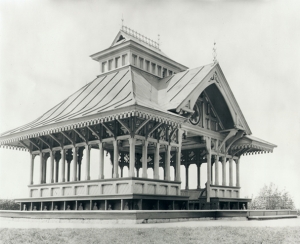I Will Gaze …
Why I haven’t looked up the dictionary definition of gazebo until now, I do not know. We’ve been thinking about gazebos for months. I just haven’t felt the need to consult the dictionary, thinking that the significance of this thing lay only in what God wanted to say through it, not in the thing itself. And it is a simple word: it is not from the ancient Greek, not theologically significant, suggests nothing profound in its sound or sense (some in our community simply dislike the word). But when I finally saw the definition this last week, it sent me spinning into a reverie about the nature of grace and revelation.
My lexical journey of discovery started on the computer, continued in the pages of the OED (Oxford Exessivelylarge Dictionary), and finally landed me in the early pages of the Gospel of John. A pieced-together definition is below, with my own emphasis and comments.
Gazebo:
A roofed structure, offering a commanding prospect, typically used for relaxation or entertainment; a belvedere (Italian, literally, beautiful view).
I like the bit about commanding prospect, and who doesn’t like a beautiful view? But that other bit is the problem in a nutshell. A structure typically used for “relaxation and entertainment”? On grand European estates, these buildings might appear some distance from the home, designed to resemble the ruins of some important ancient building, a small temple for example; these were called follies. This is not (at first blush) an idea that merits consideration alongside of questions of faith and life. You don’t have serious conversations about gazebos. This is where you go after a serious conversation to chill out. But it continues, and again, it doesn’t look like we’re going to plumb any intellectual depths here.
… Origin, mid 18th cent., perhaps humorously from gaze, in imitation of Latin future tenses ending in –ebo (that is, “I shall gaze“: compare with lavabo, a basin used for the ritual washing of a celebrant’s hands at the offertory of the Mass in the Catholic Church; a washing trough in a monastery.
More frivolity. It’s kind of a silly, invented word. And at first I could see no reason at all why the authors of the dictionary would choose the Latin word Lavabo as an example of an -abo/-ebo future-tense ending. What does washing have to do with gazebos? Any latin word in the future tense would do. It seems arbitrary.
But then, like a splash of cold water, it hit me. As I was thinking about the gazebo, and wondering about its definition … I came to see a kind of serendipity in the comparison between washing and resting; between ritual cleansing, and ‘entertainment’. Let’s take the rabbit-elevator down one more floor. In the following passage from John’s Gospel, watch for the way Jesus pulls the old switcheroo at a small town wedding when (almost) nobody was looking.
There was a wedding in Cana of Galilee, and the mother of Jesus was there. Jesus and his disciples had also been invited to the wedding. When the wine gave out, the mother of Jesus said to him, “They have no wine.” And Jesus said to her, “Woman, what concern is that to you and to me? My hour has not yet come.” His mother said to the servants, “Do whatever he tells you.” Now standing there were six stone water jars for the Jewish rites of purification, each holding twenty or thirty gallons. Jesus said to them, “Fill the jars with water.” And they filled them up to the brim. He said to them, “Now draw some out, and take it to the chief steward.” So they took it. When the steward tasted the water that had become wine, and did not know where it came from (though the servants who had drawn the water knew), the steward called the bridegroomand said to him, “Everyone serves the good wine first, and then the inferior wine after the guests have become drunk. But you have kept the good wine until now.” (John 2.1–10 NRSV)
This is more than Jesus’ first public miracle. Yes it is a miracle–a sign of the power of God working in the man. But there is a story being told here as well. Let’s unpack it. Jesus could have asked the servants to fill up the empty wine bottles with water for this miracle. Why did he have them fill up the jars meant for “rites of purification”? So. This is what’s known as a prophetic act.
With this act, Jesus hijacks a symbol of our need for repeated purification, and converts it to a symbol of joy, of celebration. The prophetic word is … ‘Where we once needed to purify ourselves before approaching God, now, in Jesus, ritual purification is superseded, and we are invited to celebrate/rest in God’s presence. Here, “relaxation” itself is not a diversion, a folly, but the very promise of God. Grace is the end of toil (for purification, for salvation). The libation of record is no longer water for purification, but wine for celebration. The building is not meant to be a place of crushing seriousness, but rest and rejoicing. From lavabo to gazebo. May I pour you a glass of wine?
For thus said the Lord God, the Holy One of Israel: In returning and rest you shall be saved; in quietness and in trust shall be your strength.
(Isaiah 30.15 NRSV)
I know that Jesus is not merely replacing a need for purification with an invitation to drink wine. Jesus’ actions in Cana are not meant to say, “You used to have to worry about daily purification, and now, look, I give you wine, so … party time!” There is no doubt that the sign of the ritual washing jars is replaced by the sign of wine-at-a-wedding, which is truly about celebration and joy. But wine is also a sign in the Christian Scriptures of another, weightier, idea. In the New Testament wine symbolizes blood, and so wine symbolizes the death of Jesus, which means that Jesus’ miracle at Cana points to the way that he would abolish the ritual sacrifices and ritual washings and endless fear of what separates us from God. His death was the end of repetitious purification, and in this way his sacrifice was the beginning of rest. When we turn aside from our endless efforts to save ourselves, we enter into his rest.
The roof of our gazebo, after all, was always meant to have Christ as its ridge beam. So to come under this roof, we hope and pray, is to come under that great work of sacrifice and purification that is the true invitation to rest and celebration.
[Image of ‘Old Gazebo on Parliament Hill Ottawa Ontario Canada’ by Ron Saumure; permission pending.]



Leave a comment